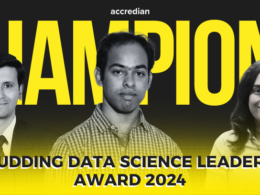An assistant professor with more than 17 years of experience in the pharmaceutical industry, Suhani Sinha is extremely intrigued by the applications of Data Science, Machine Learning and linear regression with machine learning in molecular biology and medicine. Wanting to know more about the different ML tools, she enrolled for the Global Certificate in Data Science (GCD) program at Accredian.
In this article, let’s see her take on the future impact of data science on medicine and how her learning experience has been at Accredian.
Question 1: Which program & batch are you part of at Accredian & tell us more about your current work profile?
Suhani: I am part of the Global Certificate in Data Science (GCD) program, June 2020 batch. I am currently working as an assistant professor at GD Goenka University. Initially, I worked in the pharmaceutical industry for 17 years. I used some of the ML packages there for a significant number of years. And that’s how I got to know about data science and became interested to learn how these algorithms like linear regression with machine learning work.
Data visualization is an essential part of any representation of data. The huge amount of experiments performed in the pharmaceutical industry does not only produce significant amounts of data but requires the same to do so. And if this data is represented in interesting ways like we learned in EDA, it will help the industry gain momentum to perform any such experiments.
Question 2: Walk us through your career journey & what got you interested in Data Science & Machine Learning?
Suhani: I got interested in Data Science and Machine Learning because AI and ML are the future in healthcare. Currently, the pharmaceutical industry is frequently repurposing molecules to synergize the biological function of drugs. And, the efficiency of the process can only be perfected when we have computer aided drug designing methods in place. This particularly fanned my interest to learn more about computational tools of linear regression with machine learning and others that will help in the various healthcare domains, especially the pharmaceutical space.
In fact Data Science and Machine Learning is going to have a huge impact on the field of healthcare in the next decade. The data generated in hospitals and clinics, not just for clinical research but in the pharmaceutical industry as well, will be put through visualization to understand the trend and so that the right model can be chosen to get favorable outputs. And this is going to go a long way in lessening research time.
Previously, we didn’t have the tools of AI and ML. But right now, with the help of these technologies, anyone can get their genetic code in a floppy. And that’s how it can help doctors as well to achieve precision in medicine compositions for patients too. After working in the pharmaceutical industry for 17 years, using various ML packages like linear regression with machine learning, I can definitely say that EDA can go a long way to understand the trends of the data.
No matter the industry, one must present data in the right way so that people or the business stakeholders are able to comprehend the trends of that data. So, I think the various data visualization and modeling techniques are significantly advantageous not just in terms of cutting research costs but also in pacing up the production and release of any new product in the market.
Question 3: What all tools and packages in Data Science & Machine Learning have you mastered in your Data Science & AI program at Accredian so far?
Suhani: I have learnt the programming language of Python and its different tools like NumPy and Pandas. I also learned about the processes of data cleaning and analysis. I got to work with excellent visualization graphs, the various ways to do a correlation between different independent factors and others.
Question 4: What were some of the initial challenges when you got started on your Data Science journey and how did you overcome it?
Suhani: My initial challenge in this course was remembering several algorithms and commands. It was very difficult. However, we were told by our mentor that we need not worry about these languages as everything we do is application-based and we can also easily run a Google search to find them. Rather than remembering them, it is more important to know how to use them. So, although it was tough in the beginning, I learned to apply them as I progressed further.
Question 5: Who is your favorite faculty at Accredian and what did you learn from him the Most?
Suhani: It is difficult to say as both Suchit and Neelmani have done an excellent job. Suchit was more clear when it came to statistical concepts. I was aware of all these concepts though, learnt and practiced them well in school. His way of teaching is commendable. He used specific visualization tools so that we do not forget the concepts. Neelmani also explained the concepts of machine learning like linear regression with machine learning, etc., very well. So I think both of them need to be complimented for that.
Question 6: In your view, how has Data Science evolved in the last few years?
Suhani: The impact of Data Science on pharmaceuticals in the past few years cannot go unnoticed. Several models are used to understand the effect of various independent factors on dependent factors. These are significant applications in any chemical reaction, be it the synthesis of any chemical entity or biological molecules. Even for the formulation, there are packages like Minitab and GMP design that help export all these statistical packages. Using the concept of machine learning and the software gives us the different models for the data that we have generated through different experiments.
Question 7: What are the current trends in Data Science that you are most excited about?
Suhani: The current trend of data science in healthcare is it has diverse applications in clinical research. Currently, numerous clinical trials are being undertaken for repurposing molecules. So, the better the data visualization tools and ML models like linear regression with machine learning, etc,. we have, the better and more accurate will be the data prediction for a particular compound or drug suitable for medical use. And, this in turn would help the pharmaceutical industry to roll out the new repurposed molecules faster in the market.
Question 8: Which are some of the blogs that you follow?
Suhani: Some of the blogs which I follow daily are ETHealthWorld, statnews.com and other pharma and health news blogs.
This was a conversation with one of our GCD students – Suhani Sinha.
Discover more such interesting student stories at Accredian Spotlight.





